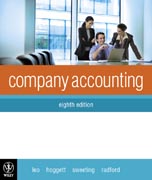
Company Accounting, 8th Edition" has been thoroughly updated to reflect the various and ongoing reforms as a result of Australia's adoption of international financial reporting standards. This edition provides an authoritative and reliable overview of the various changes required within the Framework and a selection of the key accounting standards governing corporate entities. Standardssuch as AASB 101 Presentation of Financial Statements (which relates to external disclosure of financial information in a set of general-purpose financial statements), AASB 3 Business Combinations and AASB 127 Consolidated and Separate Financial Statements. The text will provide students with a comprehensive and practical grounding in the practice and principles of company accounting. The 8th edition presents essential 'must know' information on accounting for a corporate entity and the requirements for externally disclosing the financial position of the entity. In this edition, Chapter 8 'Business Combinations' hasbeen updated to reflect changes with AASB 108 'Business Combinations' as a result of the Exposure Draft of Proposed Amendments to IFRS 3. All chapters on consolidation of financial statements (chapters 14 to 18) have been updated in accordance with AASAB 127 Consolidated and Separate Financial Statements. New disclosure requirements, a consequence of AASB 101 Presentation of Financial Statements, are fully integrated. Discussion of dividends updated as a consequence of changes in reporting and measurement requirements. This title is revised to accord with changes in AASB as a consequence of continuing reforms with IFRS. More 'Learning Check' summaries in all chapters reiterate and summarise important concepts. New 'Student Activity Section' in each chapter contains a summary, demonstration problems, discussion questions, case studies, graded exercises and problems. Reorganised end-of-chapter sections contain more diverse activity scenarios for students in an attempt to develop a broader skill base.'Learning Checks' support chapter learning objectives and summarise key knowledge for students. They appear throughout each chapter and are ideal for self-study purposes. Thorough illustrative examples and demonstration problems withvarious examples supported with step-by-step narrations. About the authors: Ken Leo, B.Com (Hons), MBA (Qld), AAUQ, ACA, FCPA is Professor of Accounting atCurtin University of Technology, Western Australia. In over 30 years as an academic, Ken has taught company accounting to undergraduate and postgraduate students. He was a founding member of the Urgent Issues Group, and has written books and monographs for a variety of organisations including CPA Australia, the Group of 100 and the Australian Accounting Research Foundation. He was a founding member of the Urgent Issues Group, serving on that body from 1995 to 2001. Ken also served on the Australian Accounting Standards Board from 2002 to 2007, both as a member and as deputy chair of the Board. John Hoggett, BCom (Hons), BTh, MFM, AAUQ, FCPA worked in universities in both Western Australia andQueensland for 35 years. During this time, he taught introductory accounting,corporate accounting and accounting theory to undergraduate and postgraduate students. John has written books and monographs for a variety of organisationsincluding CPA Australia and the Group of 100, and has been involved in secondary education with the Curriculum Council of Western Australia. John Sweeting,BEc, MEc, PhD, CPA, CA is a Senior Lecturer in Accountancy at Queensland University of Technology. John's background includes a mixture of academic and business positions. He has taught at Swinburne University of Technology and the University of Central Queensland, and has spent time with the National Companies and Securities Commission (now the Australian Securities and Investments Commission). John has also held positions with a large international chartered accounting firm and a large manufacturing/retailing company listed on the Australian Securities Exchange. He has written for professional journals, and his main area of research is external reporting and profit forecasts in prospectuses. In addition to running in-house courses for accounting firms, John has also conducted Professional Development courses for CPA Australia and The Instituteof Chartered Accountants in Australia. He has also been actively involved in both the CPA Program and the CA Program. Jennie Radford, BCom, DipEd, MCom, ACA, recently retired from the School of Accounting at Curtin University of Technology. She has co-authored two research monographs published by Group of 100 and CPA Australia. She has also co-authored and co-edited several textbooks. Jennie was for many years employed as an auditor with 'Big 5' chartered accounting firms. During her academic career, Jennie taught undergraduate and postgraduate courses in financial accounting and corporate accounting. She is a member of the Western Australia Cell of the External Reporting Centre of Excellence(with CPA Australia). INDICE: Chapter 1: Nature and regulation of companies Chapter 2: Financingcompany operations Chapter 3: Company operations Chapter 4: Accounting for income tax Chapter 5: Property, plant and equipment Chapter 6: Leases Chapter 7:Intangible assets Chapter 8: Business combinations Chapter 9: Impairment of assets Chapter 10: Disclosure: legal requirements and accounting policies 11: Disclosure: presentation of financial statements Chapter 12: Fundamental concepts of corporate governance for accountants Chapter 13: Disclosure: Cash flow statements Chapter 14: Controlled entities: the consolidation method Chapter 15: Consolidation: wholly owned subsidiaries Chapter 16: Consolidation: intragroup transactions Chapter 17: Consolidation: minority interest Chapter 18: Consolidation: indirect ownership interests Chapter 19: Accounting for investments in associates Chapter 20: Liquidation of companies
- ISBN: 978-0-470-81973-9
- Editorial: John Wiley & Sons
- Encuadernacion: Rústica
- Páginas: 1116
- Fecha Publicación: 11/11/2008
- Nº Volúmenes: 1
- Idioma: Inglés
